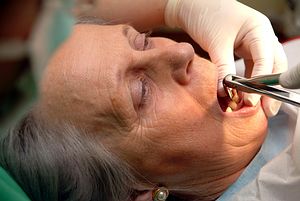Stay Ahead of The Curve by Improving Geriatric Patient Care
In many medical fields, geriatrics make up a large portion of a patient base. Dentistry is no exception. As people age, not only do conditions like dry mouth emerge, but physical ailments like arthritis can make dental care difficult. Now that the elderly represent more than 14 percent of the U.S. population, doctors everywhere need to step up their game to accommodate this growing demographic. Read on to find out how your practice can cater to patients 65 and older.

Asking older patients about their medications, even supplements, is crucial for satisfactory care.
The Population Reference Bureau (PRB) forecasts a nearly two-fold increase in the number of Americans older than 65, but geriatric oral healthcare availability is struggling to keep pace.
“Older adults are in greater need for oral health care services than ever before, yet they may be the least likely to receive services,” says Professor Jonathan Ship, D.M.D. from the New York University College of Dentistry.
RELATED: More Coverage on
- Improve Your Network to Expand Horizons
- The 7 Streams: Is Your Passive Income Enough?
- 4 Common Mistakes Dentists Make When Planning for Retirement
Here are some key takeaways from the American Dental Association’s (ADA) best practice guidelines for geriatric dental care.
Age Related Oral Health Risks
Xerostomia (dry mouth), caries, periodontitis and drug sensitivity are more prevalent in older adults. Monitor elderly patients closely for these issues and modify their homecare regiments for additional prevention. The ADA recommends transitioning elderly patients to electronic toothbrushes and encouraging regular fluoride rinses.
Older adults may have increased sensitivity to medications, especially to those related to pain management.
“Geriatric patients commonly have cardiovascular disease and, thus, the dose of epinephrine contained in anesthetics should be limited to a maximum of 0.04 milligrams,” said Aviv Ouanounou, D.D.S and Daniel Haas, D.D.S. in the Journal of the Canadian Dental Association (JCAD).
With the multitude of age related ailments, older patients may take relatively large variety of medications. Be sure to consider the patient’s entire medical history to minimize the risk for adverse effects or drug interactions. Patients may neglect to include non-prescription medications and herbal supplements in their medical information forms. Ask patients specifically about vitamins, health supplements and over-the-counter medications to minimize risk.
Effective Treatment Planning and Communication
Older patients are more likely to suffer from cognitive impairments that make it difficult to remember postoperative instructions. The ADA recommends modifying treatment plans to account for this and increase the likelihood of treatment success.
“Because cognitive impairment or dementia can affect a patient’s ability to follow instructions following oral surgery, it is recommended that practitioners ensure local hemostasis (i.e., sutures, local hemostatics, socket preservation techniques) prior to dismissal from the dental practice,” the ADA wrote.
Effective communication with patients who have audio or visual impairments may also improve the quality of homecare. Speak loudly and slowly but do not belittle the patient or use an offensive tone. When discussing treatment plans and postoperative instructions, remove your mask and face the patient to facilitate lip reading and transmission of non-verbal ques.
Good lighting, large print and contrasting colors visually emphasize important information. You can reduce discomfort by informing the patient of equipment changes that cause altered tactile sensations — such as switching between low and high-speed drills.
Geriatric patients may have physical impairments that can make effective dental care challenging.
“Osteoarthritis or rheumatoid arthritis in the hand, fingers, elbow, shoulder, and/or neck can affect a person’s ability to maintain good quality oral health self-care.”
Consider providing patients with modified equipment to make brushing easier. The ADA suggests modifying manual toothbrushes with Velcro straps, electronic toothbrushes with wide handles, Floss holders and interdental brushes.